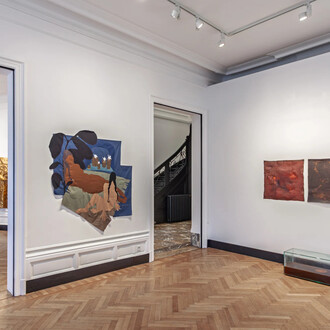For a decade, Malherbe has been using the steep Normandy coast as starting point to a more and more liberated, expressive and incarnated gesture.
The particular interest the artist finds in this rocky landscape and his way of translating it into painting, reveals a fusional relationship to the mineral world.
He often says that these landscapes are an « excuse to painting » but his pictorial power is nourished by this ever changing subject. It is the chaos of matter, a reflection of the world’s disorder, he depicts and is magnetised to.
The shore’s crevices become the artist’s refuge. After hours painting what he sees, he brings backs to the studio dozens of small canvases. There happen both the doubts and the struggle to pursue the sensations experienced on site, and transform them into a new energy. Outside, Guy de Malherbe uses painting in order to assimilate the landscape where as inside the studio it is the landscape he uses to create paintings.
Each element- brushstroke, form and colour- used to create a landscape becomes a tool to build a painting. The vivacious brushstrokes inscribed on to the small square canvases transform themselves by ricochet to give birth to a new - purely pictural -universe, a concrete object as well as an imaginary territory. The Steles, strange objects, vestiges of enigmatic constructions, act like screens throwing their powerful shadows onto the sand while letting the eye catch a glimpse of a chaotic and luminous hereafter. That is what is at stake, notably, in this impressive 2,10 x 3 m‘s canvas. In other paintings, the amounts of accumulated rocks, somehow anthropomorphic, are worked at times in a transparent manner, at times with more texture. Water and clouds are treated with large brushstrokes of blue and brown tones Guy de Malherbe puts us in front of the sky and sea or, maybe more accurately, in front of painting itself.
What this exhibition shows once again is how Guy de Malherbe’s entrenchment in the physical experience of nature is irreplaceable to his work. The artist, from one piece to the other, reveals or hides, the elements dear to him with more or less intensity. And conveys imagery as much as symbols which in turn assert his painting as a truly powerful poetic gesture.
















